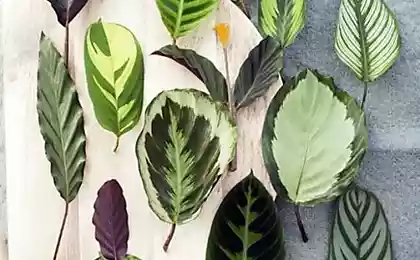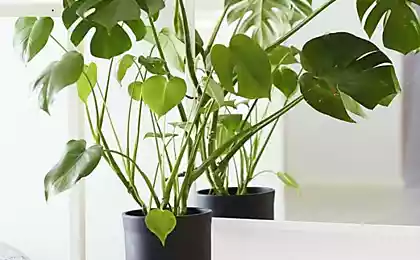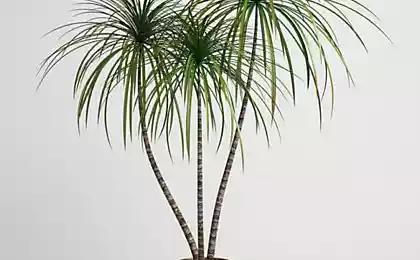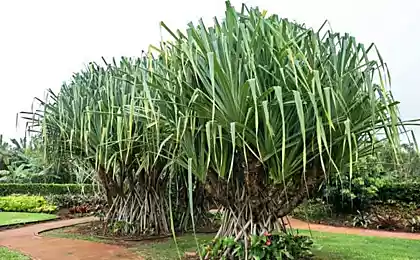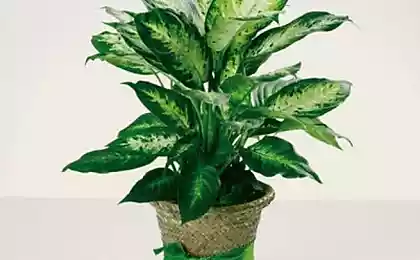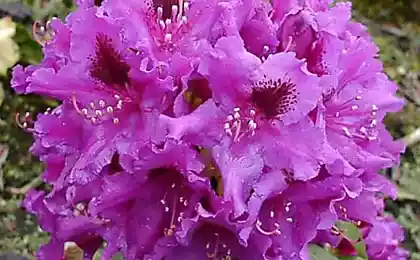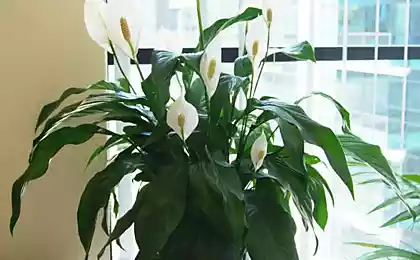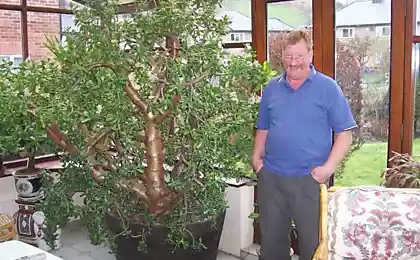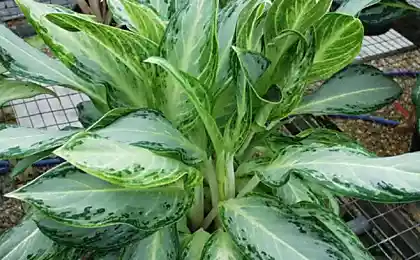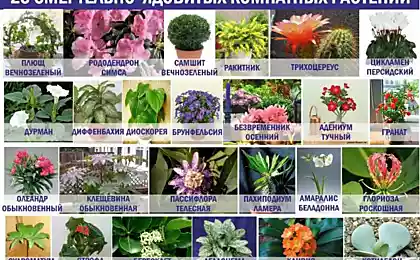1559
Puya chilensis: plant eaten by the sheep
This gigantic plant entices sheep into the trap, and when they die, sucking out their nutrients. For the first 15 years of its existence it has bloomed.
The scientific name of this plant, "Puya chilensis» (Puya chilensis). It grows in a greenhouse Royal Horticultural Society, which is located outside of London. The height of the plants with bright dangerous spikes up three and a half meters.
In his native Andean plant uses spikes to grab the sheep and other animals. Were trapped animals die of starvation, and the insidious plant sucks nutrients from their decomposing bodies.
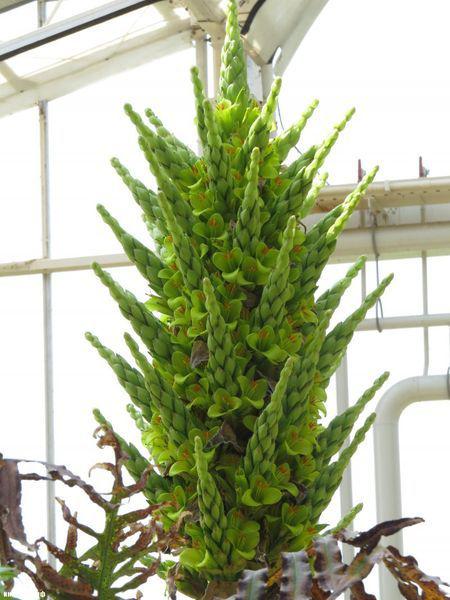
In captivity, it is virtually puya blooms because of its unusual "diet." However, a British garden still managed to make his fastidious pet flourish, feeding it with liquid fertilizer. The flowers of this plant are quite large, about five centimeters in diameter. The Royal Horticultural Society argue that every flower "enough nectar to drink human».
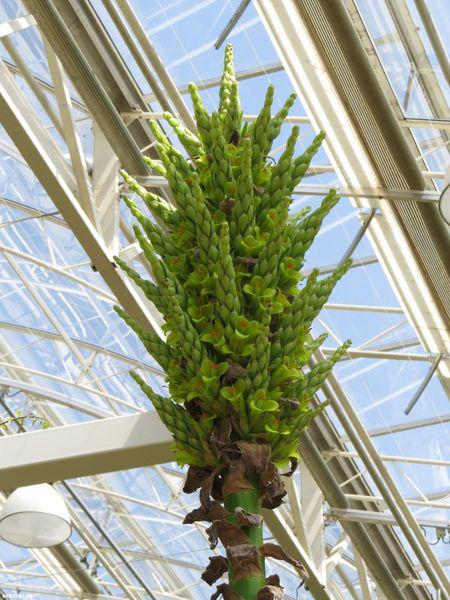
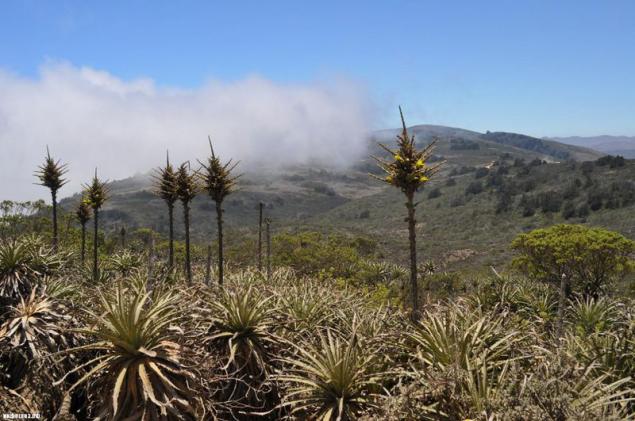
Knowing what is in the nature of every course, I rushed to check on the internet - silence. Nothing like this do not write about it, and close the plant. There are no clues.
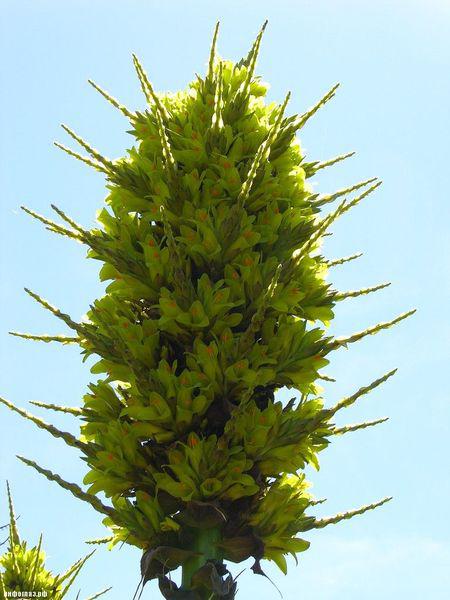
And that's what they write:
Plants up to 1 m tall, with a woody, branched stems kandelyabrovidno. The leaves are large, up to 1 m long, very narrow, 0.4-0.5 cm wide, the edges are usually rolled, dense with thorns, head back, bluish-green. Peduncle up to 1.5 m tall, branched rzhavoopushenny. Flowers to 5 cm in diameter, yellow.
At room conditions Puyyu not planted in deep round bowls filled with a mixture of leaf soil, sand, expanded clay aggregate, taken in equal proportions with the addition of charcoal. Watering is very neat, well-defended water at room temperature. In nature Puia receives mainly moisture from the atmosphere, so it is necessary to provide a high humidity environment. To this end, the container containing the plant on a pallet filled with gravel and water, is sprayed regularly. Do not tolerate waterlogging the substrate and need good drainage. Central hopper must always be filled with water, in an area with hard water should use rainwater. Every two months, change the water in the funnel. The soil should be watered only when dry. Feeding liquid complex fertilizer for orchids and bromeliads spend 1 per month from May to August, after spraying. Content summer- temperature about 18 ° C, 12-14 ° C in winter.
Propagated by seeds and root suckers (side sockets).
Seeds are sown in a sterile substrate deciduous earth and sand. Moisturize from a spray, cover glass or film and germinated at t = 18-22 ° C. Advantageously the process of seed germination affects swings night and day temperatures.
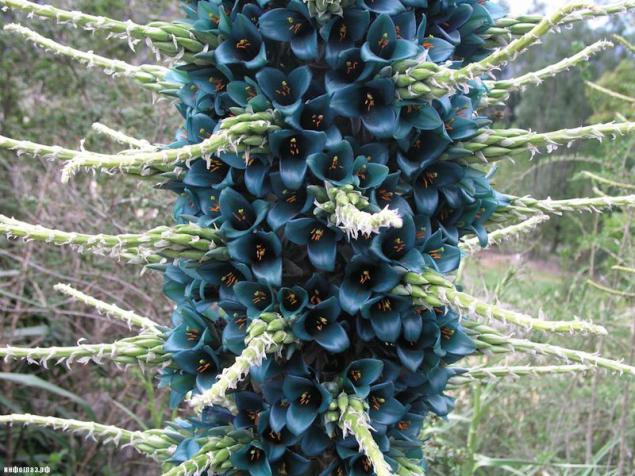
Well, maybe this is what some other Puya? Let's read what characterized the whole race:
Rhode Puja (in the language of the Mapuche «puya» - tip), it has 222 species of plants. Described in 1782 by the Chilean priest and naturalist, botanist Juan Ignacio Molina. The genus is confined primarily to the Andean region, including in Brazil, Chile, Argentina, Bolivia, Peru, Ecuador, Colombia, Venezuela, Costa Rica. The genus belongs to the family of Bromeliads (Bromeliaceae).
Grow mainly in the mountainous regions of the Andes, met on dry slopes, high mountain plateau in the mountain forests, as well as (deletion) in the swamps. Perennial, polycarpic rarely monocarpic, ground herbs xerophytes. The root system is strong, branched; roots mostly basal, but species with prostrate stems can be formed in different parts thereof, thus contributing to vegetative reproduction; rare (exception) there is stored tuberous education. Stems simple or branched, often more or less thick (1 to 5 m in diameter) are coated with scars of leaf; sometimes strongly shortened stem. Leaves in rosettes, linear, usually with wide vagina, grooved, tough, leathery, more or less succulent, the edges often with strong spikes covered with scales, at the bottom, bottom, or less frequently on both sides.
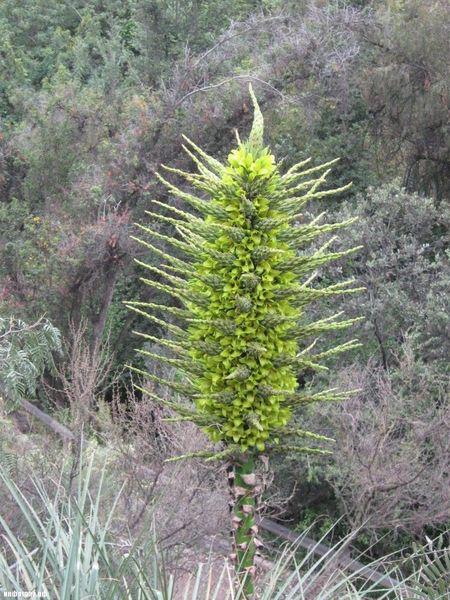
Peduncles basal, usually long, strong, more or less thick, naked or covered with scales, are bracts: the bottom like a leaf rosette, the upper usually broadly oval with a sharp tip at the edge often with spines, leathery or thin, membranous, sometimes deciduous ; rarely stems reduced. Inflorescence simple or complex, racemose, spicate, paniculate, more or less dense, many-flowered, or loose, few-flowered; rarely inflorescence reduced to a single flower. Flowers actinomorphic, on stalks, with bracts leathery or thin bumagovidnym, painted or unpainted. Sepals free, uzkotreugolnye or broadly oval, pointed or blunt; usually leathery, naked or covered with scales often do not exceed the length of the petals. Petals free, oval or broadly, usually blunt or sometimes with a small cusp, always longer than sepals, shades of yellow, blue, red, green, or white. Perianth after flowering twisted spiral. Stamens free, slightly shorter than petals. Fruit lokulitsidnaya or rarely late septitsidnaya box. Seeds are small, with dorsiapikalnym, wing-appendage.
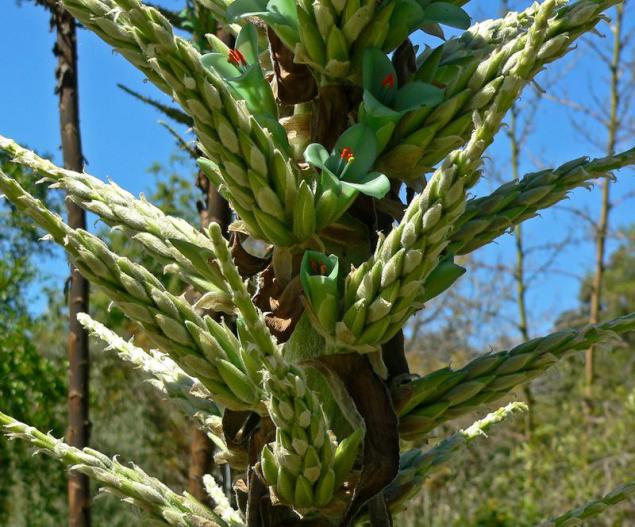
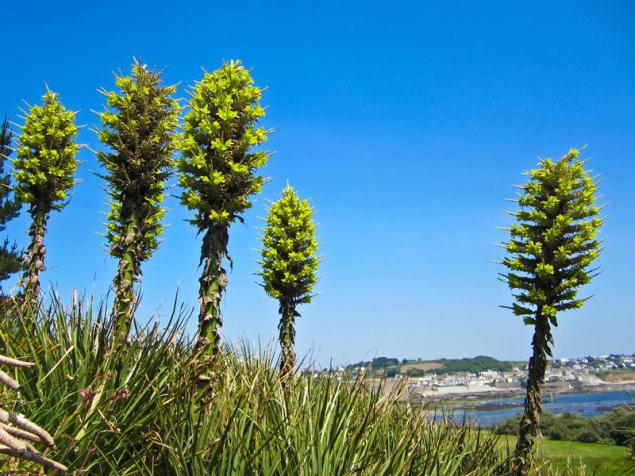

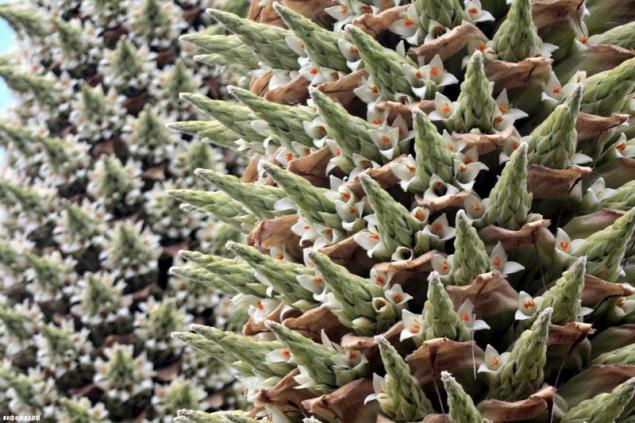
Puja Raymond (Puya Raimondii) - amazing Bromeliads plant family (which also includes pineapple and many ornamental plants) spread only in a small area of the Andes of Peru and Bolivia. Puya known that it has the world's largest inflorescence, which can reach a height of twelve meters and three meters in diameter. Also in the inflorescence Pouilly Raymond, there are about ten thousand of simple flowers. This plant is not only amazing, but also very rare. Today, its population does not exceed a few hundred thousand, but once upon a time, back in prehistoric times puya Raymond met in those places at almost every turn, in general, scientists have found the remains of four hundred and fifty thousand plants, and how much more completely sunk into oblivion and present complicated.
As noted earlier, the puya Raymond - a rare plant that is found no more than one copy per square kilometer in the areas of growth. Puja grows only in the highlands at an altitude of about four thousand meters above sea level, the ideal for her is only the conditions of the Andes, where the temperature depending on the season, ranging from very low to moderate. For the first time this plant has found Frenchman Charles Alcide d'Orbigny, who in 1830 explored the alpine flora of Bolivia. But puya named after the Italian scientist Antonio Raimondi, who lived in Peru and gave issledovaniiyu plant almost all his life, was he released his first work on this unique representative of the South American flora. The general public is a wonderful plant became known only in 1948 when the editor of the magazine «National Geographic» arrived in Bolivia, and two years later published a detailed article and photos.

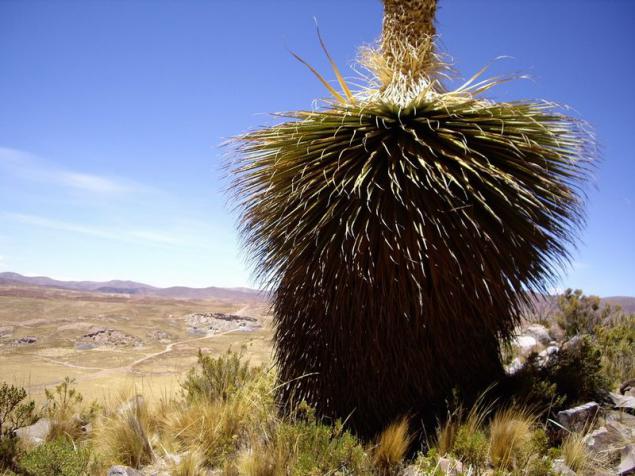
Today puyyu Raymond can be found only in three places in Peru Ancash, Kahamarkuilla and Kathak. And in one of rayonav Bolivia - mountains Comanches, who are in the department of La Paz. That is where the national park, which is considered a sanctuary Pouilly Raymond. And it was open almost by accident. In 1906 a miner Jorge Machikado Silva bought the estate in the eighteen thousand hectares, on which he began to breed sheep, produce gypsum and mineral water. These lands once considered wild, and even hostile, but Machikado could make them beautiful land which is suitable not only for work but also for a wonderful holiday. Soon the former miner remarked on the territory of their estates wonderful plant colossal proportions, he was so impressed by them that opened eight hectares, which met puya Raymond for free visits to all comers. In 1963, Bolivian President Paz Estenssoro issued a decree stating that the plant Comanche mountains are true rarities prehistoric, so eight hectares Machikado estates were turned into national park.
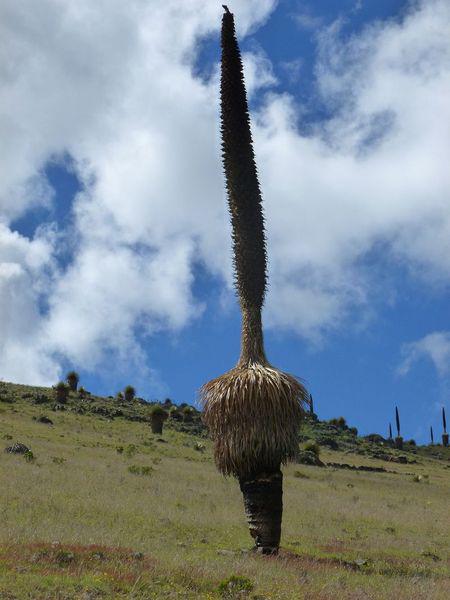
Currently, Bolivia and Peru, the authorities are doing everything possible to save this amazing plant dinosaur. In addition to the adoption of special laws and the creation of parks and reserves made artificial pollination. Also puyyu Raymond implement as part of landscaping at the national level. It is also a wonderful plant trying to grow away from the natural conditions of its growth. Pouilly were placed in a number of botanical gardens around the world. So it was planted in the botanical garden of the University of California in 1958, but thirty years later, it has blossomed and then died. In general, the measures taken have helped to stop the extinction of this rare plant, and soon, perhaps, the population of Pouilly Raymond will slowly but surely grow.
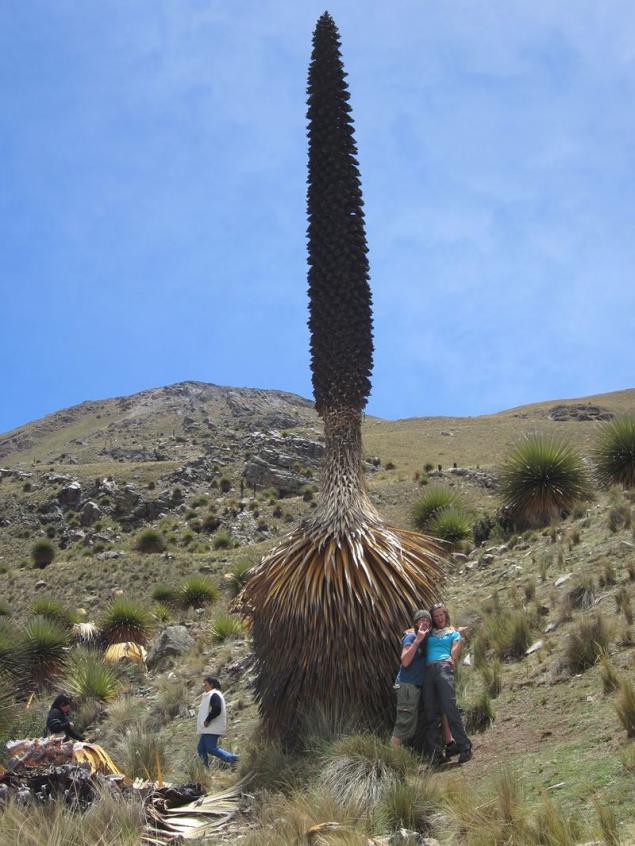
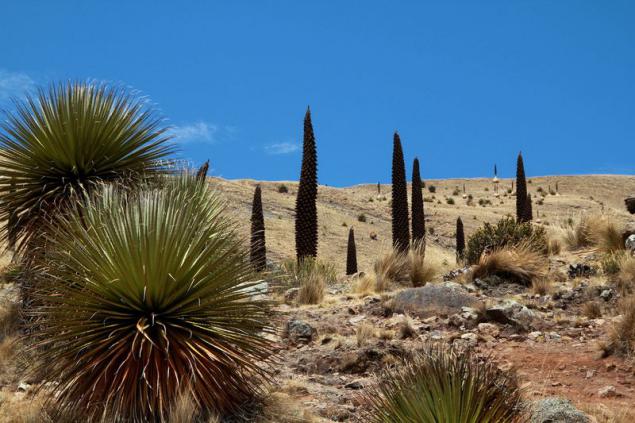

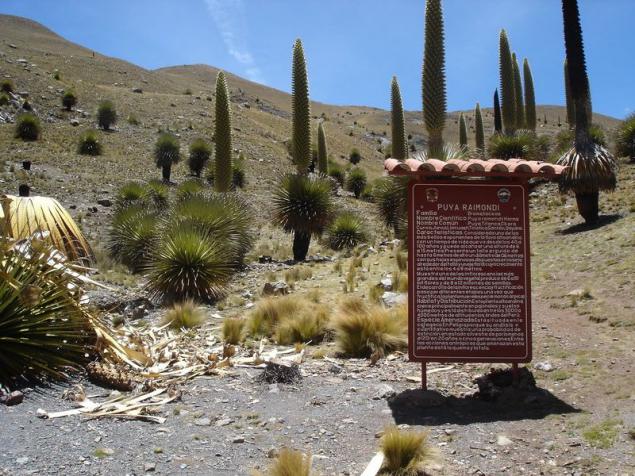
Source: masterok.livejournal.com
The scientific name of this plant, "Puya chilensis» (Puya chilensis). It grows in a greenhouse Royal Horticultural Society, which is located outside of London. The height of the plants with bright dangerous spikes up three and a half meters.
In his native Andean plant uses spikes to grab the sheep and other animals. Were trapped animals die of starvation, and the insidious plant sucks nutrients from their decomposing bodies.

In captivity, it is virtually puya blooms because of its unusual "diet." However, a British garden still managed to make his fastidious pet flourish, feeding it with liquid fertilizer. The flowers of this plant are quite large, about five centimeters in diameter. The Royal Horticultural Society argue that every flower "enough nectar to drink human».


Knowing what is in the nature of every course, I rushed to check on the internet - silence. Nothing like this do not write about it, and close the plant. There are no clues.

And that's what they write:
Plants up to 1 m tall, with a woody, branched stems kandelyabrovidno. The leaves are large, up to 1 m long, very narrow, 0.4-0.5 cm wide, the edges are usually rolled, dense with thorns, head back, bluish-green. Peduncle up to 1.5 m tall, branched rzhavoopushenny. Flowers to 5 cm in diameter, yellow.
At room conditions Puyyu not planted in deep round bowls filled with a mixture of leaf soil, sand, expanded clay aggregate, taken in equal proportions with the addition of charcoal. Watering is very neat, well-defended water at room temperature. In nature Puia receives mainly moisture from the atmosphere, so it is necessary to provide a high humidity environment. To this end, the container containing the plant on a pallet filled with gravel and water, is sprayed regularly. Do not tolerate waterlogging the substrate and need good drainage. Central hopper must always be filled with water, in an area with hard water should use rainwater. Every two months, change the water in the funnel. The soil should be watered only when dry. Feeding liquid complex fertilizer for orchids and bromeliads spend 1 per month from May to August, after spraying. Content summer- temperature about 18 ° C, 12-14 ° C in winter.
Propagated by seeds and root suckers (side sockets).
Seeds are sown in a sterile substrate deciduous earth and sand. Moisturize from a spray, cover glass or film and germinated at t = 18-22 ° C. Advantageously the process of seed germination affects swings night and day temperatures.

Well, maybe this is what some other Puya? Let's read what characterized the whole race:
Rhode Puja (in the language of the Mapuche «puya» - tip), it has 222 species of plants. Described in 1782 by the Chilean priest and naturalist, botanist Juan Ignacio Molina. The genus is confined primarily to the Andean region, including in Brazil, Chile, Argentina, Bolivia, Peru, Ecuador, Colombia, Venezuela, Costa Rica. The genus belongs to the family of Bromeliads (Bromeliaceae).
Grow mainly in the mountainous regions of the Andes, met on dry slopes, high mountain plateau in the mountain forests, as well as (deletion) in the swamps. Perennial, polycarpic rarely monocarpic, ground herbs xerophytes. The root system is strong, branched; roots mostly basal, but species with prostrate stems can be formed in different parts thereof, thus contributing to vegetative reproduction; rare (exception) there is stored tuberous education. Stems simple or branched, often more or less thick (1 to 5 m in diameter) are coated with scars of leaf; sometimes strongly shortened stem. Leaves in rosettes, linear, usually with wide vagina, grooved, tough, leathery, more or less succulent, the edges often with strong spikes covered with scales, at the bottom, bottom, or less frequently on both sides.

Peduncles basal, usually long, strong, more or less thick, naked or covered with scales, are bracts: the bottom like a leaf rosette, the upper usually broadly oval with a sharp tip at the edge often with spines, leathery or thin, membranous, sometimes deciduous ; rarely stems reduced. Inflorescence simple or complex, racemose, spicate, paniculate, more or less dense, many-flowered, or loose, few-flowered; rarely inflorescence reduced to a single flower. Flowers actinomorphic, on stalks, with bracts leathery or thin bumagovidnym, painted or unpainted. Sepals free, uzkotreugolnye or broadly oval, pointed or blunt; usually leathery, naked or covered with scales often do not exceed the length of the petals. Petals free, oval or broadly, usually blunt or sometimes with a small cusp, always longer than sepals, shades of yellow, blue, red, green, or white. Perianth after flowering twisted spiral. Stamens free, slightly shorter than petals. Fruit lokulitsidnaya or rarely late septitsidnaya box. Seeds are small, with dorsiapikalnym, wing-appendage.




Puja Raymond (Puya Raimondii) - amazing Bromeliads plant family (which also includes pineapple and many ornamental plants) spread only in a small area of the Andes of Peru and Bolivia. Puya known that it has the world's largest inflorescence, which can reach a height of twelve meters and three meters in diameter. Also in the inflorescence Pouilly Raymond, there are about ten thousand of simple flowers. This plant is not only amazing, but also very rare. Today, its population does not exceed a few hundred thousand, but once upon a time, back in prehistoric times puya Raymond met in those places at almost every turn, in general, scientists have found the remains of four hundred and fifty thousand plants, and how much more completely sunk into oblivion and present complicated.
As noted earlier, the puya Raymond - a rare plant that is found no more than one copy per square kilometer in the areas of growth. Puja grows only in the highlands at an altitude of about four thousand meters above sea level, the ideal for her is only the conditions of the Andes, where the temperature depending on the season, ranging from very low to moderate. For the first time this plant has found Frenchman Charles Alcide d'Orbigny, who in 1830 explored the alpine flora of Bolivia. But puya named after the Italian scientist Antonio Raimondi, who lived in Peru and gave issledovaniiyu plant almost all his life, was he released his first work on this unique representative of the South American flora. The general public is a wonderful plant became known only in 1948 when the editor of the magazine «National Geographic» arrived in Bolivia, and two years later published a detailed article and photos.


Today puyyu Raymond can be found only in three places in Peru Ancash, Kahamarkuilla and Kathak. And in one of rayonav Bolivia - mountains Comanches, who are in the department of La Paz. That is where the national park, which is considered a sanctuary Pouilly Raymond. And it was open almost by accident. In 1906 a miner Jorge Machikado Silva bought the estate in the eighteen thousand hectares, on which he began to breed sheep, produce gypsum and mineral water. These lands once considered wild, and even hostile, but Machikado could make them beautiful land which is suitable not only for work but also for a wonderful holiday. Soon the former miner remarked on the territory of their estates wonderful plant colossal proportions, he was so impressed by them that opened eight hectares, which met puya Raymond for free visits to all comers. In 1963, Bolivian President Paz Estenssoro issued a decree stating that the plant Comanche mountains are true rarities prehistoric, so eight hectares Machikado estates were turned into national park.

Currently, Bolivia and Peru, the authorities are doing everything possible to save this amazing plant dinosaur. In addition to the adoption of special laws and the creation of parks and reserves made artificial pollination. Also puyyu Raymond implement as part of landscaping at the national level. It is also a wonderful plant trying to grow away from the natural conditions of its growth. Pouilly were placed in a number of botanical gardens around the world. So it was planted in the botanical garden of the University of California in 1958, but thirty years later, it has blossomed and then died. In general, the measures taken have helped to stop the extinction of this rare plant, and soon, perhaps, the population of Pouilly Raymond will slowly but surely grow.




Source: masterok.livejournal.com




